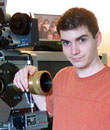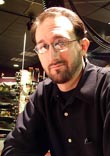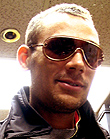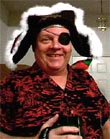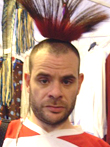|
|
This topic comprises 2 pages: 1 2
|
|
Author
|
Topic: New technique for copying historic audio recordings
|
Leo Enticknap
Film God

Posts: 7474
From: Loma Linda, CA
Registered: Jul 2000
|
 posted 07-23-2004 10:42 AM
posted 07-23-2004 10:42 AM





quote:
Getting back into the groove
By Maggie Shiels
In San Francisco
Queen Victoria, Abraham Lincoln, Florence Nightingale and other characters from history may soon be able to speak again, as scientists perfect techniques to recover the sound from recordings that are far too delicate to be played.
In the corner of a California university laboratory, two men are battling against time to perfect a machine that will read old recordings - using special microscopes to scan the grooves - and software that can convert those shapes into sound. Their work could bring history to life.
The dulcet tones of movers and shakers from an earlier age could soon be heard once again, thanks to scientists Vitaliy Fadeyev and Carl Haber, who usually work with subatomic particles at the Lawrence Berkeley National Lab. They are now planning to use that technology to give a voice to the great and the good down the annals of history.
Haber says the idea came to him by accident after he heard a radio report about the problems archivists have in preserving and accessing the voices and music of the past. He says a lightbulb went on in his head.
Why not adapt the precision techniques he and Fadeyev are using in a European-led project on particle physics, and apply it to old recordings? Made perfect sense to him.
"We stumbled on the idea and kind of made a connection," explains Haber. "To us, it's a wonderful way forward where basic research in the physical sciences can be made to work for another field of research or culture, which you might naively think was unrelated to particle physics. "Of course these are all the human endeavours and it's wonderful they can benefit each other. "
Russian-born Fadeyev agrees: "It's great that our very technical field can give benefits to other humanitarian activities."
Their first experiments involved extracting high quality sound from old shellac discs from the 1950s. The two scientists programmed a precision optical metrology system normally used to inspect silicon detectors, to map and photograph the undulating grooves etched on these old recordings. The result was a digital reproduction with all the scratches, bumps, dust and wiggles ironed out. Those images were then transferred to a computer and turned into a sound file to produce a clean version of the original.
The beauty of this technique is that nothing ever has to touch the actual recording, thereby avoiding any further damage to it. "It's like a fancy Xerox machine," quips Haber. Early success in reviving The Weavers' 1950 rendition of the classic Huddie Ledbetter song Goodnight Irene suggested the two scientists were on to something.
And the US Library of Congress, in Washington, DC, backs that view. It has given the scientists funding to perfect their technique and technology in the hope it can be used to access a huge archive. The library's files include 128 million items in formats ranging from tape to disc and from wax cylinders to tin foil cylinders.
In the past, the library has said that America's audio heritage is in danger. At least half of the wax cylinders used to record sound before 1902 are gone, because no one bothered to preserve them or because they weren't properly stored.
Fungal mould and insects have been the main culprits in silencing the voices of Americans from legendary eras such as the Civil War, the conquest of the western states, and the early days of slavery. "They have lost as many cylinders to the mould as to breakages and other causes, so mould is definitely one of the major destructors of this old media," says Fadeyev.
In the corner of another Berkeley lab, two men are battling against time to perfect a machine that will read old cylinders using special microscopes to scan the grooves and software to convert those shapes into sound.
In an early successful experiment, scientists John McBride and Christian Maul from Southampton University helped retrieve data from a well worn 1912 cylinder recording of a sentimental tune called Just Before the Battle, Mother. In Berkeley, it was translated into a sound file.
Haber says, "A stylus measures a groove by one point, essentially where the stylus sits. The data we take is taken at least a factor of ten if not at a higher sampling or resolution than the stylus measures. So if you have ten times as much information, you have that much more of a chance to recover something. And we could even maybe go 20 or 30 times and increase our chances even more so."
Both men are excited at the possibilities in being able to give voice once again to cylinders that are said to contain recordings of Queen Victoria, poets Alfred Tennyson and Walt Whitman, nurse Florence Nightingale, actress Sarah Bernhardt and Germany's WWI leader Kaiser Wilhelm.
Rumours abound that Abraham Lincoln even made a recording during the Civil War in 1863. "History is something that everyone shares. When you can see it or hear it, that real time experience of it happening in front of your can awaken a whole other dimension for people," says Haber.
Vitaliy believes breathing new life into recordings that have been thought unplayable might also change the way we view the past.
"I think it's hard to quantify, but it's certainly a great cultural and emotional imprint. The very first sample that we reconstructed was the Goodnight Irene song. It's thought of as a lullaby these days, but if you listen to the lyrics it's about adultery, murder and some other things. That immediately gives you the feeling for the cultural change between the 1930s, 40s, 50s, and these days."
Link
Sounds like a great idea, and one which could potentially be used to combat format obsolescence as well as issues with the physical condition of an original element, too. For example, if it would be possible to devise a way of producing a photographic record of the pattern of magnetic particles on a videotape, I guess you could potentially decode its content into whatever is the current format at the time, without having to worry about maintaining complex electromechanical hardware.
| IP: Logged
|
|
|
|
|
|
|
|
|
|
|
|
|
|
Mitchell Dvoskin
Phenomenal Film Handler
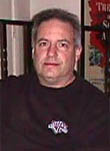
Posts: 1869
From: West Milford, NJ, USA
Registered: Jan 2001
|
 posted 07-24-2004 10:33 AM
posted 07-24-2004 10:33 AM




Speaking as someone who owns a working Edison Cylinder Phonograph and a bunch of cylinder records dating back to the early 1890's, I have a few comments. First, the needle assembly on these phonographs are very light, unlike disk phonographs of the day. Second, the groove on these records is not used to move the arm foward, the phonograph mechanism does this, unlike disk phonographs of the day. These machines were designed to repeatedly play soft wax cylinders with minimal wear. The fact that I have wax cylinder records that play almost as well today, 110 years after they were manufactured, speaks volumes. Most original disk records from that time a would be very worn out.
The point of above, is that while the people who are developing this electron microscope grove reading technology are doing amazing work, they are taking the long road without any clear benefit. It would be far easier to just record these records, either directly or using a modified version of the existing laser TT pickup, and then doing de-hissing/popping. Understanding how these cylinder records were recorded, manufactured, and intended to be played, I'm not sure picking up more information from the groove will produce more acurate results. I tend to think all you will pick up is more defects and dust, which will then have to be digitally removed. I suppose I just don't see what benefit they hope to achieve over existing technology.
| IP: Logged
|
|
|
|
|
|
|
|
|
|
|
|
|
|
|
|
|
|
All times are Central (GMT -6:00)
|
This topic comprises 2 pages: 1 2
|
Powered by Infopop Corporation
UBB.classicTM
6.3.1.2
The Film-Tech Forums are designed for various members related to the cinema industry to express their opinions, viewpoints and testimonials on various products, services and events based upon speculation, personal knowledge and factual information through use, therefore all views represented here allow no liability upon the publishers of this web site and the owners of said views assume no liability for any ill will resulting from these postings. The posts made here are for educational as well as entertainment purposes and as such anyone viewing this portion of the website must accept these views as statements of the author of that opinion
and agrees to release the authors from any and all liability.
|

 Home
Home
 Products
Products
 Store
Store
 Forum
Forum
 Warehouse
Warehouse
 Contact Us
Contact Us




 Printer-friendly view of this topic
Printer-friendly view of this topic







![[thumbsup]](graemlins/thumbsup.gif)
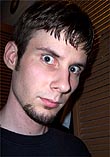
![[Big Grin]](biggrin.gif)

